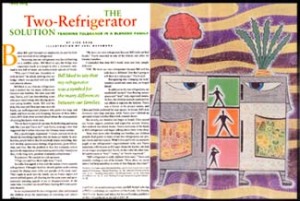The Two-Regrigerator Solution: Teaching Tolerance in a Blended Family

The Two-Refrigerator Solution: Teaching Tolerance in a Blended Family
By Lisa Cohn
Reprinted with permission from Mothering Magazine (www.mothering.com).
Before Bill and I formed our stepfamily, he and his kids were terrified of my refrigerator.
Venturing into my refrigerator was like embarking on a wildlife safari, Bill liked to say; the fridge was organized much like a jungle after a monsoon rain. And it was full of many yet-undiscovered species of foods.
“Why can’t I find any chocolate or milk in here?” he asked, peeking into my fridge, which was packed with soy milk and almond cheese.
Bill liked to say that my refrigerator was a symbol for the many differences between our families. My nine-year-old son, Travis, and I are free-wheeling types who pour much energy into playing sports and eating healthy foods. Bill and his kids, five-year-old Chris and nine-year-old Emily, are well-organized planners who prefer hot dogs and candy and love movies and shopping. Because of these differences, Bill’s kids often worried out loud about the consequences of uniting his family with mine.
“Do we have to spend all our time Rollerblading and eating tofu like Lisa and Travis do?” said Emily, making a face that suggested she’d rather volunteer for Chinese water torture.
Bill, a psychologist, responded: “I know you kids think we should do everything together after we form our family. In stepfamilies, people believe that if everybody shares everything, they will develop spontaneous feelings of generosity, good fellowship, and love. But the problem is that this romantic notion ignores the importance of maintaining interfamilial boundaries that, in the long-term, promote stepfamily cohesiveness.”
Translation: We needed two refrigerators.
“I’ll go out and buy them right now,” I said.
Actually, I struggled at first with the notion of two separate refrigerators. I thought families should gather each evening around the dining-room table and partake of the same meal. They ought to pack into the family van on Friday nights and attend softball games, all cheering for the same team and spontaneously emitting squeals of joy or disappointment. At the same time, I couldn’t see myself force-feeding Bill’s kids carob-tofu desserts.
So we implemented the two-refrigerator plan and lectured the children about the importance of tolerating each other’s differences.
“We have our own refrigerator because Bill’s kids eat bad foods,” Travis reported to one of his friends just after we blended families.
I reminded him that Bill’s foods were not bad, simply different.
“OK. We have our own refrigerator because Bill and his kids have a ‘different’ diet that’s going to kill them at a young age,” Travis said.
Recognizing that changing our kids’ mindsets would take time, we forged ahead.
In addition to the two refrigerators, we established “project” (free-flowing, messy) spaces and “neat” (tidy, organized) rooms. At first, the children seemed comforted by our efforts to separate the families. Travis was a fixture in the project rooms, and Chris and Emily preferred the neat spaces. At dinner, Bill’s kids devoured corn dogs and pop, while Travis and I nibbled on sprouted-wheat tortillas filled with almond cheese.
But slowly, our families did begin to blend. Chris tasted our frozen organic potatoes and sugar-free spritzer drinks, then ordered two dozen boxes. Travis eyed some of the foods in Bill’s refrigerator and began talking about them in his sleep.
Now, four years after blending our families, our children proudly lead guests on tours of our two refrigerators, our project rooms and neat spaces. While Chris and Emily occasionally giggle at my refrigerator’s organizational style, and Travis sometimes rolls his eyes as Bill super-cleans the kitchen, the kids are no longer as judgmental. Rarely do they label the other family’s preferences as “bad,” “messy,” or “overly organized.”
“Bill’s refrigerator is really different than ours,” Travis said recently, smiling at one of his friends. “How about we sneak into it and help ourselves to some of that Belgian chocolate?”
###
Lisa Cohn, an award-winning writer, and Bill Merkel, who has a Ph.D. in psychology, are coauthors of “One Family, Two Family, New Family: Stories And Advice For Stepfamilies,” published by RiverWood Books in the fall of 2003.